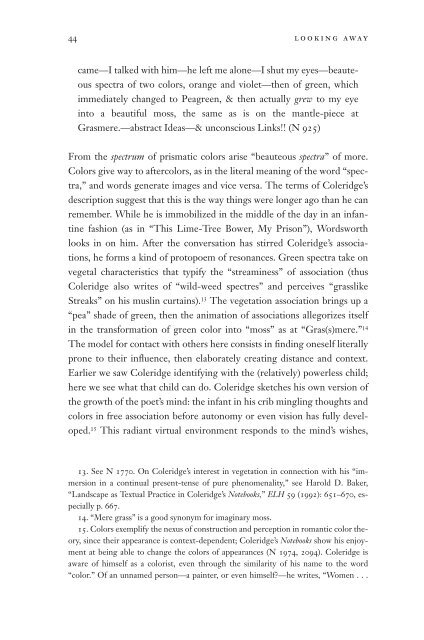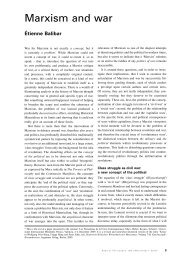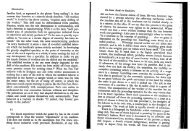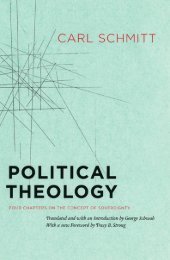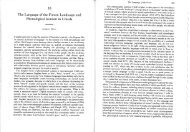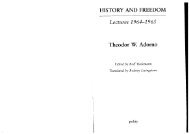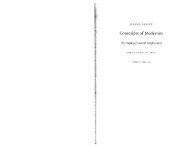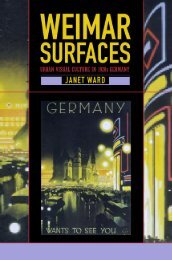Terada - Looking Away (Selections).pdf - Townsend Humanities Lab
Terada - Looking Away (Selections).pdf - Townsend Humanities Lab
Terada - Looking Away (Selections).pdf - Townsend Humanities Lab
You also want an ePaper? Increase the reach of your titles
YUMPU automatically turns print PDFs into web optimized ePapers that Google loves.
44 looking away<br />
came—I talked with him—he left me alone—I shut my eyes—beauteous<br />
spectra of two colors, orange and violet—then of green, which<br />
immediately changed to Peagreen, & then actually grew to my eye<br />
into a beautiful moss, the same as is on the mantle-piece at<br />
Grasmere.—abstract Ideas—& unconscious Links!! (N 925)<br />
From the spectrum of prismatic colors arise “beauteous spectra” of more.<br />
Colors give way to aftercolors, as in the literal meaning of the word “spectra,”<br />
and words generate images and vice versa. The terms of Coleridge’s<br />
description suggest that this is the way things were longer ago than he can<br />
remember. While he is immobilized in the middle of the day in an infantine<br />
fashion (as in “This Lime-Tree Bower, My Prison”), Wordsworth<br />
looks in on him. After the conversation has stirred Coleridge’s associations,<br />
he forms a kind of protopoem of resonances. Green spectra take on<br />
vegetal characteristics that typify the “streaminess” of association (thus<br />
Coleridge also writes of “wild-weed spectres” and perceives “grasslike<br />
Streaks” on his muslin curtains). 13 The vegetation association brings up a<br />
“pea” shade of green, then the animation of associations allegorizes itself<br />
in the transformation of green color into “moss” as at “Gras(s)mere.” 14<br />
The model for contact with others here consists in finding oneself literally<br />
prone to their influence, then elaborately creating distance and context.<br />
Earlier we saw Coleridge identifying with the (relatively) powerless child;<br />
here we see what that child can do. Coleridge sketches his own version of<br />
the growth of the poet’s mind: the infant in his crib mingling thoughts and<br />
colors in free association before autonomy or even vision has fully developed.<br />
15 This radiant virtual environment responds to the mind’s wishes,<br />
13. See N 1770. On Coleridge’s interest in vegetation in connection with his “immersion<br />
in a continual present-tense of pure phenomenality,” see Harold D. Baker,<br />
“Landscape as Textual Practice in Coleridge’s Notebooks,” ELH 59 (1992): 651–670, especially<br />
p. 667.<br />
14. “Mere grass” is a good synonym for imaginary moss.<br />
15. Colors exemplify the nexus of construction and perception in romantic color theory,<br />
since their appearance is context-dependent; Coleridge’s Notebooks show his enjoyment<br />
at being able to change the colors of appearances (N 1974, 2094). Coleridge is<br />
aware of himself as a colorist, even through the similarity of his name to the word<br />
“color.” Of an unnamed person—a painter, or even himself?—he writes, “Women . . .


